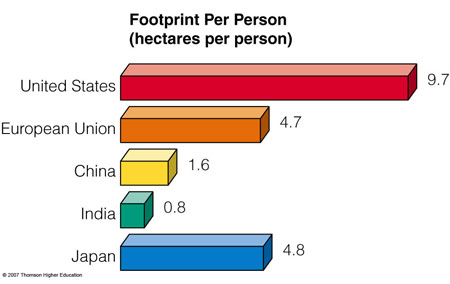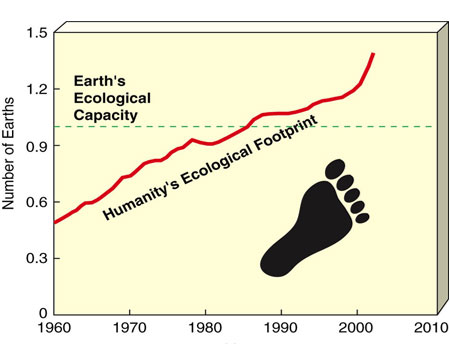Topic 2.2 Population & Consumption: The whole story
Let’s return to Ehrlich and Holden’s equation I = P x A x T. We have just discussed the fact that the world’s population (P) is increasing, so according to this equation, the environmental impact will continue to increase for some time. But of course this is only one part of the story, and many would argue that it is less important than the effect of affluence (A) or per unit consumption. In this topic, we will review patterns of resource consumption globally and within Australia.
In this topic, we will discuss:
- patterns of consumption around the world and within Australia
- the role of technology.
What is Consumption?
Various definitions of "consumption" have been proposed. The Royal Society of London and the US National Academy of Sciences chose to define consumption as "the human transformation of materials and energy". In this unit, we will refer to consumption as the use or transformation of resources by humans so that it is unavailable for other purposes.
Consumption Patterns
We will now consider the world’s consumption patterns, which vary enormously between regions. For example, only 20% (approximately 1.2 billion) of the world’s population lives in the developed countries, yet we consume 60% of the world’s food, 75% of its metals and 85% of its wood (Hartmann 2001, In Clashing views, p. 126).
| Consumes | Produces |
|---|---|
| 26% of all oil | 50% of all toxic waste |
| 24% of all aluminium | 26% of all nitrous oxides |
| 20% of all copper | 25% of all sulphur oxides |
| 19% of all nickel | 22% of all CFCs |
| 13% of all steel | 26% of CO2 |
Table 1 presents the quantities of resources used and waste produced by the USA alone. These figures are staggering given they have less than 5% of the world’s population. Yet are Australians, or indeed Territorians much less resource hungry?
![]()
Activity 2.9
Visit the Australian Bureau of Statistics ![]() web site.
web site.
Scroll down to Table 4,‘Selected energy indicators for World regions and Australia-1997' which shows energy consumption of Australian’s compared to other OECED countries, and to the rest of the world.
- How does Australia compare to the global average? Are we large consumers of energy (i.e. do we have a high use per person)? How do we compare to non-OECD countries (i.e., the developing nations)?
- Refer to Table 6 on the same Web site. How do Northern Territorians compare to other Australian States and Territories with respect to energy consumption?
Activity 2.10
A breakdown of resource consumption per capita for countries around the world is available as a PDF file.
- Review Australia's per capita consumption (listed near the end of the table under 'Oceania'. Is Australia's level of consumption increasing, decreasing or has it stabilized? List some of the reasons why consumption levels have increased in Australia (reviewing data at the Australian Bureau of Statistics might give you some ideas).
- Compare Australia’s consumption level to that of a developing nation such as India. How does it compare to the United States of America?
- How does the environmental impact of one Indian person compare to that of an Australian?
The disparity between consumption levels of developed versus developing nations raises many points for debate. In particular, what will be the environmental impact of an increasingly western lifestyle of people in developing nations? How can developed nations try to limit aspirations for this lifestyle, when they have done little to limit their own consumption levels?
Throughout the remainder of this semester, we will discuss consumption of resources and their environmental impacts. Clearly, despite the high level of environmental awareness of Australian's and the environmental damage that our lifestyle is causing, we are not yet prepared to lower our consumption levels.
![]()
Ecological Footprint
An ecological footprint is the amount of land needed to produce the resources used by an average individual in a country. As you can see from Figure 1-13 (Miller & Spoolman (2012) page 16, estimates of the relative ecological footprints of nations demonstrate how many more resources the individuals in some nations, such as the USA, use compared to others.


Read Miller & Spoolman (2012) Pages 15-17. Refer also to Supplement 8 p.S38-S39.
Assessment Item 1
Your Personal Consumption Patterns
Assessment Item 1 provides the opportunity for you to assess your own consumption level, and compare it to the NT and other states. The details of this assessment item are provided in the Assessment box, and we will discuss your findings in the tutorial class.
Technology
The final component of the Ehrlich and Holden’s equation I = P x A x T that we need to discuss is the role of Technology (T).
Technological innovations can substantially alter the environmental impact of human population and their resource consumption. Many argue that Malthus' prediction of famine and disaster was wrong because he did not account for technological innovation. Can you think of examples in which technology has been used to reduce environmental impact? One example might be the development of alternative forms of energy supplies. Another might be the development of much more effective irrigation systems, which minimise the massive waste of water due to evaporation and runoff. Another hotly debated technological opportunity, which we will discuss later in the semester, is the development of genetically modified organisms.
Alternatively, can you think of examples in which technology caused increased environmental impact? There are many, particularly the advances in the industrial revolution during which the development of motorized vehicles, coal-burning factories, use of earth-moving and building technologies to build dams etc had a massive impact on the environment.
Technological change has an important role in creating environmental problems, and could be an integral part of solving them (Yenken & Wilkinson, p. 53). Throughout the semester, we will consider technological opportunities to minimise environmental impact.
![]()
Review Questions
1. Do you think that resource consumption is an important environmental issue?
2. Analyse the following statement. “Population growth in the developed world is of little concern to the future of the planet. It is population growth in the developing world that is out of control and needs to be addressed.”
![]()
